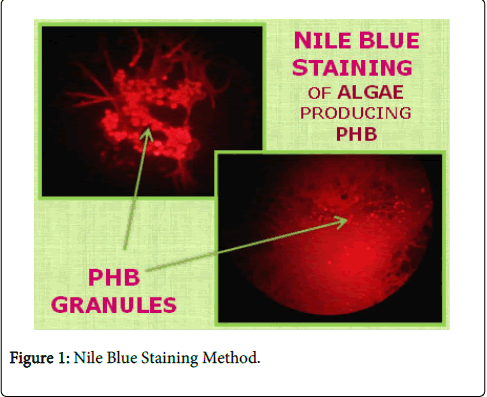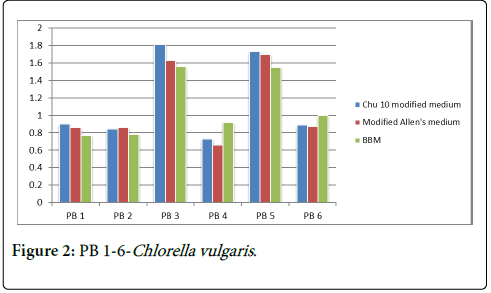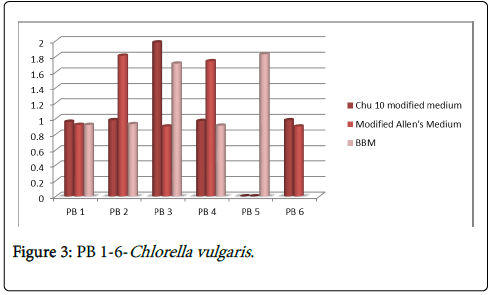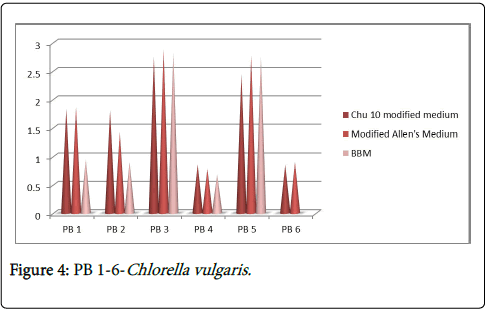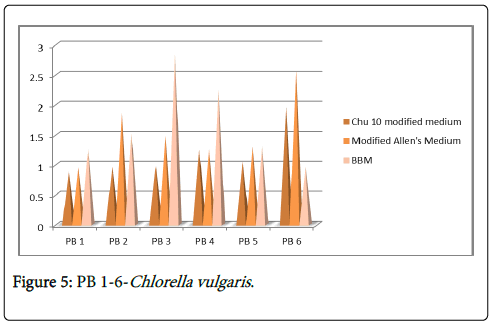Isolation and Optimization of PHB (Poly-β-hydroxybutyrate) Based Biodegradable Plastics from Chlorella vulgaris
Received: 08-Feb-2018 / Accepted Date: 15-Feb-2018 / Published Date: 19-Feb-2018 DOI: 10.4172/2155-6199.1000433
Abstract
Poly-β-hydroxybutyrate (PHB) can be used as an effective thermoplastic and has many characteristics similar to those of standard commercial plastics like polypropylene. PHB based plastic substitutes are less flexible than traditional plastics; they are completely biodegradable and leave behind no residue. Algae are used for the production of PHB, for bioplastic production which offers an opportunity in economic efficiency by reduced costs. Chlorella vulgaris PB (1-6) was isolated from different freshwater sources and screened for PHB production using Sudan black B and Nile Blue Stain. The production of PHB was optimized using different media and under various parameters like Aeration; Effect of phosphate and Sodium acetate etc. PHB was extracted using hot chloroform and the amount of PHB produced was estimated by reading the absorbance at 235 nm.
Keywords: PHB; Chlorella vulgaris PB (1-6); Biopolymers; Nile blue; Biodegradation
Introduction
Bioplastics or organic plastics are a form of plastics derived from renewable biomass sources such as vegetable oil, corn, starch, pea starch unlike fossil-fuel plastics derived from petroleum. Biodegradable form of plastic was first characterized in the mid 1920’s by French researchers. This molecule is called Polyhydroxybutyrate (PHB). Many different types of bacteria and algae produce it as food storage material [1]. Biodegradable plastics can decompose into carbon-dioxide, methane, water, inorganic compounds or biomass via microbial assimilation. Algae serve as an excellent feedstock for plastic production owing to its many advantages such as high yield and the ability to grow in a range of environments [2].
In this paper, Algae are used for the production of PHB. Industrial utilization of Algae as PHB producers has the advantage of converting waste carbon-dioxide, a greenhouse gas to environmental friendly plastics using the energy of sunlight.
Materials and Methods
Sample collection
Samples were collected from different freshwater habitats of Tamilnadu which includes Muttukaddu lake, Elagiri lake, Tuticorin; Panderavellai; Alandur and WCC pond water.
Isolation and purification
The algal species were isolated and purified from different sources using basic microbial techniques primarily with serial dilution and followed by spread plating and quadrant streaking on BBM (Bold’s Basal Medium) agar plates. Morphological identification was performed through microscopic observations.
Culture conditions
The purified axenic cultures were grown in 250 ml Erlenmeyer flasks containing 100 ml of BBM. Experimental cultures were incubated at 25+2°C, 14/10 light/dark cycles with illumination of 3000 lux under cool white fluorescent lamps. Every day the cultures were mildly shaken by hand for 10 minutes.
Screening for the production of PHB using sudan black staining technique
The isolates were stained with Sudan Black stain. The samples were stained for 10 mins with Sudan Black Solution, rinsed with water and counter stained with 0.5% safranin for 5 mins. The slide was observed under the microscope at 1000 x magnification.
Nile blue staining technique
Heat fixed cells were treated with 1% Nile blue for 10 minutes and was observed at an excitation wavelength of 460 nm.
Analytical procedure
The algal cultures were centrifuged at 10,000 rpm for 5 minutes to obtain cell pellet. The pellet was used to estimate the wet cell weight (WCW in g/ml) [3] and dry cell weight (DCW in g/ml).

Optimization of media
The following media was prepared and the isolated six Chlorella vulgaris PB (1-6) obtained from different sources were inoculated and incubated at 14/10 light/dark cycle with illumination of 3000 lux under cool white fluorescent lamps. Every day the cultures were mildly shaken by hand for 10 mins.
Media’s used
• Cyanophycean medium
• Chu 10 Medium
• Fogg’s Nitrogen free Medium
• BG 11 Medium
• Chu 10 Modified Medium
• Algae culture Medium
• Modified Allen’s Medium
• Hughes and Gorham Medium
• Bold’s Basal Medium (BBM).
Effect of aeration on PHB production
Chlorella vulgaris PB (1-6) were inoculated into three different selected media. Based upon their growth and production of PHB these media’s were selected. They include BBM; Modified Allen’s Medium and Chu 10 modified medium. Air was supplied into the medium through the aerator. After two weeks, growth was observed and PHB was extracted. The amount of PHB extracted was quantified using UV spectrophotometer at 235 nm.
Effect of phosphate deficiency on PHB production
To study the impact of phosphorous deficiency on PHB accumulation the Chlorella vulgaris PB (1-6) was directly grown in all the 3 media’s which were devoid of phosphates.
Effect of darkness on PHB production
To study the impact of darkness on PHB accumulation, Chlorella vulgaris PB (1-6) were directly grown in BBM, Modified Allen’s Medium and Chu 10 modified medium and incubated in darkness.
Effect of sodium acetate on PHB production
1 g/l of sodium acetate was added to BBM, Modified Allen’s Medium and Chu10 modified medium. The cultures were incubated, observed for growth and PHB was extracted.
Determination of standard curve
According to Khanafari et al. [4] the standard curve was derived by preparing the PHB standard solution at different concentration (10-100 ug/ml). About 2 ml of concentrated sulphuric acid was added to all the tubes and kept in boiling waterbath for 10 mins for the conversion of PHB into crotonic acid. After cooling, the absorbance was measured at 235 nm using UV spectrophotometer and standard graph was plotted. 2 ml of concentrated sulphuric acid was used as blank. The readings were plotted in standard graph of crotonic acid and concentrations of PHB in the sample were determined.
Extraction of poly-β-hydroxybutyrate
100 ml of sample was taken and centrifuged at 10,000 rpm for 15 minutes. The supernatant was discarded and the pellet was treated with 10 ml of sodium hypochlorite and the mixture was incubated at 30°C for 2 hours. After incubation, the mixture was centrifuged at 5000 rpm for 15 minutes and then washed with distilled water and methanol respectively.
After washing, the pellet was dissolved in 5 ml of boiling chloroform. The chloroform solution was concentrated to a small volume. A volume of cold methanol was added and the sample was refrigerated overnight. The precipitated PHB was collected by centrifugation.
Results And Discussion
Isolation of PHB producing algae
Based on microscopic observations, the isolates were identified as Chlorella vulgaris PB (1-6) around six Chlorella vulgaris PB (1-6) were isolated from six different sources.
Screening for the production of PHB using sudan black and nile blue staining technique
The PHB granules were also recognized by their affinity for the dye Sudan Black, which is a presumptive test for the presence of PHB. The stained preparations were examined under a compound microscope with an oil immersion lens for determining cellular PHB accumulation. The PHB granules were observed in black color and cells were pink in all the six Chlorella vulgaris PB (1-6) cultures (Figure 1).
In Nile Blue Staining Method, the PHB inclusions exhibited a bright orange strong fluorescence.
Optimization of media
Growth was observed after 2 weeks. There was no growth in Fogg’s Nitrogen Free Medium. BBM; Modified Allen’s Medium and Chu 10 modified medium showed more amount of PHB production than others. These 3 Medias were further used for PHB production. The amount of PHB produced is shown in the following graph (Figure 2).
Effect of aeration on PHB production
After 2 weeks, growth was observed and PHB was extracted. The residual biomass and the amount of PHB accumulated were shown in the following graph (Figure 3).
Aeration is an important criteria for the production of PHB in algae. Cell growth increased at higher aeration rates, and maximum biomass production was observed.
Effect of phosphate deficiency on PHB production
Growth was observed within 7 days of cultivation in Phosphate starved medium. Limitations of phosphorous appeared to be a suitable stimulant for PHB production (Figure 4).
Effect of darkness on PHB production
There was no production of PHB in darkness, which clearly explains that algae have the ability to accumulate PHB under photoautotrophic condition [5].
Effect of sodium acetate on PHB production
Growth occurred within 4 days of incubation, which clearly shows that sodium acetate activates the growth as well as it increases the production of PHB (Figure 5).
Discussion
In this study, six strains of Chlorella vulgaris labeled as Chlorella vulgaris PB1-PB6 have been isolated from six different freshwater sources. PHB is accumulated under conditions of nutrient deprivation or in the presence of excess acetate. Three different media’s were optimized for the production of PHB and each strain showed different PHB accumulations. Among the six strains of Chlorella vulgaris PB 1-6, Chlorella vulgaris PB3 from Muttukadu Lake, Chennai showed maximum PHB production.
Aeration is an important criteria for the production of PHB in algae. Cell growth increased at higher aeration rates, and maximum biomass production was also observed.
Phosphorous starved media appeared to be a suitable stimulant for PHB accumulation where the culture showed increased PHB synthesizing ability, which amounts to maximum PHB production.
Intracellular accumulation of PHB seems to be related to the ability of the algae to grow in the presence of acetate. Normally the PHB production of the organism was induced by α-ketothiolase enzyme. The enzyme was inhibited by free coenzyme A. However in the presence of high amount of acetyl CoA the inhibitory effects of coenzyme A is overcome. The addition of sodium acetate to medium will monitor the acetyl CoA activity. Hence the medium was optimized by using sodium acetate [6].
Conclusion
To conclude, environmental conditions do play an important role in the production of PHB from Chlorella vulgaris PB (1-6). Although it is isolated from different freshwater sources, their PHB production varies from one source to another, which may depend on their respective ecosystems, where environment plays a major role in their production.
At present, PHB production from photosynthetic microorganisms to produce biodegradable plastics as an alternative to conventional plastics is considered to be cost effective and eco-friendly compared to bacterial production of PHB.
Further studies on these isolates for improved PHB production will improve the ability to discover unexploited industrially important microalgae present in the environment.
Chlorella vulgaris do have the potential to produce biopolymers like PHB from co2 as the sole carbon source, and the yield of PHB could be increased by various nutrient limiting conditions etc. The technology routes for the production of algae based bioplastics that are still under the research phase and are far from commercialization.
Algal based bioplastics can play a vital role as an environment friendly and biodegradable alternative compared to conventional plastics.
References
- Falcone DB (2004) Biodegradable Plastic in the environment. MSC Thesis, UFSCar, Sao Paulo, Brazil.
- Balaji S, Gopi K, Lavanya B, Muthuvelan B (2011) Isolation and optimization of Poly- β- hydroxybutyrates producing Cyanobacterial strains. International Journal of Applied Biology and Pharmaceutical Technology 3: 137-145.
- Beyalti Y, Aslim B, Katircioglu H, Yuksekdag ZN (2006) Determination of PHB production in different growth medium by cyanobacteria. Pakistan Journal of Biological Sciences 9: 45-47.
- Khanafari A, Akhavan SA, Mogharab M (2006) Production and recovery of Poly- β-hydroxybutyrate from whey degradation by Azotobacter. Iran J Environm Health Sci Eng 3: 193-198.
- Byrom D (1987) Polymer synthesis by microorganisms: technology and economics. Trends in Biotechnology 5: 246-250.
- Vincenzini M, Sili C, De Philippis R, Ena A, Materassi R (1990) Occurrence of poly-beta-hydroxybutyrate in Spirulina species. Journal of Bacteriology 172: 2791-2792.
Citation: Robert R, Iyer PR (2018) Isolation and Optimization of PHB (Poly-β-hydroxybutyrate) Based Biodegradable Plastics from Chlorella vulgaris. J Bioremediat Biodegrad 9: 433. DOI: 10.4172/2155-6199.1000433
Copyright: © 2018 Robert R, et al. This is an open-access article distributed under the terms of the Creative Commons Attribution License, which permits unrestricted use, distribution, and reproduction in any medium, provided the original author and source are credited.
Select your language of interest to view the total content in your interested language
Share This Article
Recommended Journals
Open Access Journals
Article Tools
Article Usage
- Total views: 9111
- [From(publication date): 0-2018 - Nov 29, 2025]
- Breakdown by view type
- HTML page views: 7804
- PDF downloads: 1307

